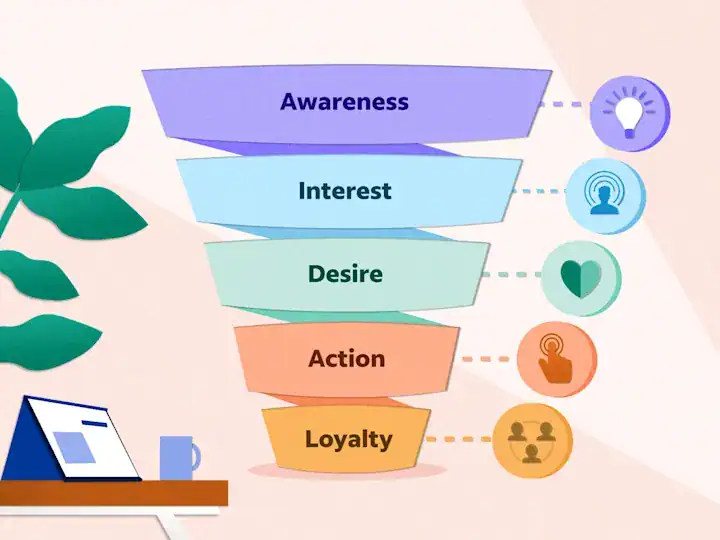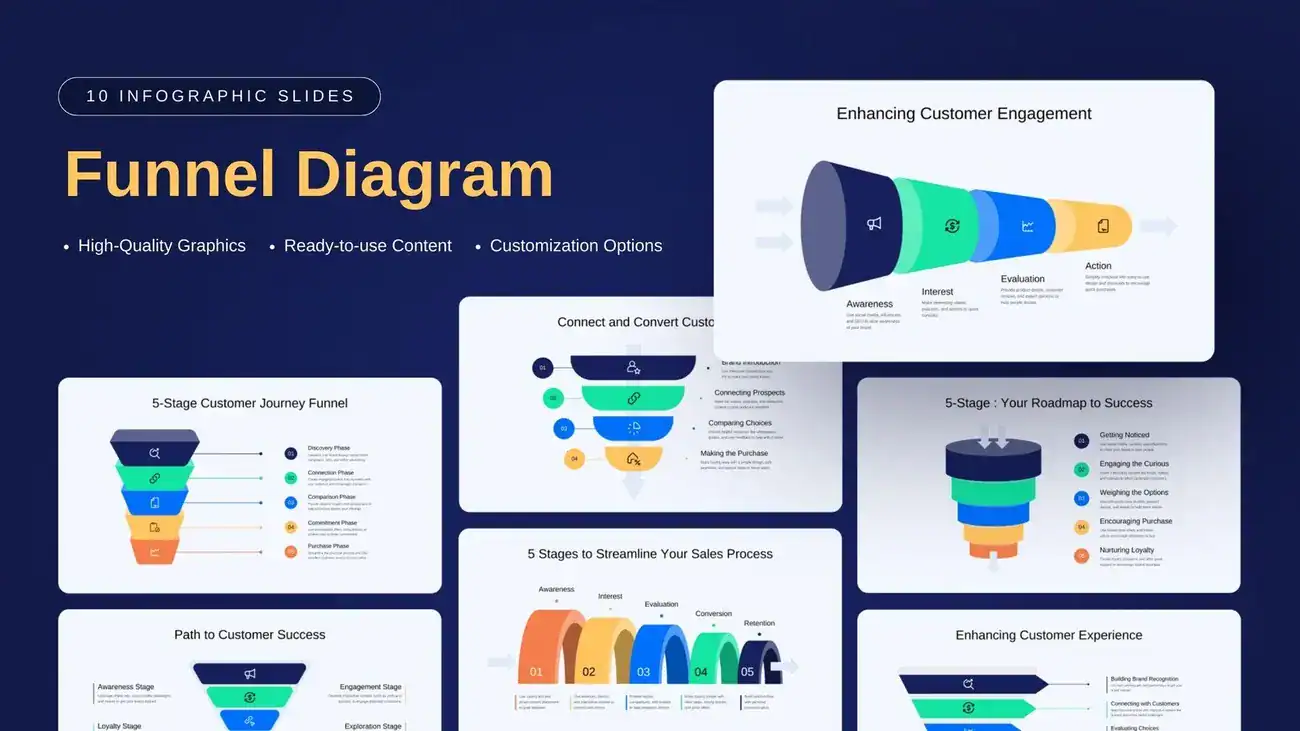What is Funnel Building? A Plain English Guide for Beginners (2025)
Funnel building creates a structured path that guides potential customers from their first interaction with your brand to making a purchase. A sales funnel looks like an actual funnel—wide at the top where many prospects enter, and narrow at the bottom where fewer, but more qualified leads convert. This all-encompassing approach helps businesses transform casual browsers into paying customers.
Funnels provide a clear roadmap for conversion and direct potential customers from awareness to action. The concept remains consistent whether you want to understand funnel meaning or what a funnel builder does. The process guides prospects through a buying journey that ends up with purchase completion. Marketing funnels commonly follow a three-stage model (Awareness, Consideration, Decision), though some sales funnels can split into five distinct stages.
This piece walks you through everything about funnel building in plain English. You’ll discover the fundamental concepts and learn to build a funnel that works for your business. We skip the complicated jargon and focus on practical advice.
What is Funnel Building?
Funnel building stands as the life-blood strategy to convert casual visitors into loyal customers in the ever-changing world of digital marketing. The concept takes its inspiration from an actual funnel’s shape—wide at the top and narrow at the bottom—showing how many prospects enter your marketing ecosystem while fewer complete the desired action.
Funnel meaning in simple terms
A funnel, in marketing terms, shows the customer’s experience from original awareness to final purchase. The marketing funnel works like a physical funnel that channels liquid into a narrow opening and guides potential customers through a well-laid-out pathway toward conversion. Cambridge Dictionary defines a funnel as “the life-blood of all e-commerce business models”.
The concept works like a real funnel—it concentrates and channels potential customers toward a specific goal. Marketers channel leads toward a purchase decision, just as you might funnel ingredients into a bottle. This systematic approach transforms a scattered audience into focused buyers through strategic steps.
What are funnels used for in marketing?
Marketing funnels serve several key purposes in a business strategy:
- Guiding the customer experience – Funnels map out and guide potential customers through the buying process toward purchase completion. A well-designed funnel creates clear pathways that help customers take desired actions.
- Measuring campaign effectiveness – Funnels let businesses track analytics at each stage and show which parts of the customer experience generate conversions and which need improvement. This measurement helps marketers understand what works and what doesn’t.
- Tailoring content appropriately – Different funnel stages need different messaging approaches. Funnels help marketers provide relevant information at the right time through the right channels.
- Increasing sales and retention – A well-designed sales funnel can drive conversions by guiding customers through purchasing. Companies that use effective funnels are 62% more likely to close high-quality sales.
Funnels concentrate and channel marketing efforts—they move leads from general brand awareness toward specific actions like making a purchase, signing up for a newsletter, or requesting more information.
Sales funnel vs. marketing funnel
People often use these terms interchangeably, but sales and marketing funnels have distinct differences:
Marketing Funnel
- Creates awareness and interest in your brand or product
- Reaches broader audiences
- Uses content-heavy elements like blog posts, social media, and advertising
- We focused on generating and nurturing leads
- Follows three stages: Awareness, Consideration, and Decision
Sales Funnel
- Targets the purchasing decision process
- Begins with qualified leads identified by marketing
- Takes a person-oriented approach with direct communications like emails and calls
- Converts interested leads into paying customers
- Follows stages like Lead Qualification, Proposal, and Closing
These funnels work together as complementary parts of the customer acquisition process, despite their differences. LinkedIn notes that “Both are basically mirror images of the same journey, seen through a different lens”. The marketing funnel typically hands off to the sales funnel when a prospect shows genuine interest in your product or service.
Businesses that understand both funnels create seamless customer experiences, from first impression to final purchase and beyond. Many companies now combine these funnels smoothly, creating comprehensive approaches that better reflect modern buying experiences.
The 5 Key Stages of a Funnel

Image Source: Indeed
A winning marketing strategy depends on knowing how prospects transform from first-time visitors into loyal customers. The traditional funnel model splits this experience into five clear stages that shape your funnel building approach.
1. Awareness
People first discover your brand at this stage. They face a problem or need but might not fully grasp it yet. They look for information through social media, blogs, search engines, and ads.
Your awareness stage goal should introduce your brand and leave a lasting impression. The content needs to educate prospects about their problems instead of pushing solutions right away. Website traffic, social media reach, and keyword rankings are important metrics to watch.
2. Interest
Prospects who know your brand move to the interest stage and dive deeper into your content. They now understand their problem better and look for possible solutions.
These potential customers want to see if your products can solve their problems. They aren’t ready to buy but want to learn more about their options. Blog posts, how-to guides, and educational resources help nurture this interest. Lead generation, email engagement, and content interaction become your key metrics.
3. Consideration
The consideration stage marks a vital point in the customer’s experience. Your prospects now have a clear view of their problem and compare different solutions. They create specific criteria and weigh various options.
Statistics show that buyers at the consideration stage consume 47% more content than at any other time. You should show why your solution stands out through detailed product information, case studies, and comparisons. Watch metrics like engagement with sales materials, demo sign-ups, and lead quality.
4. Action
The action stage (or conversion/decision stage) is where prospects decide to buy. They’ve looked at their options and feel ready to commit. You need to clear any final buying hurdles and make the conversion process smooth.
About 64% of customers spend more with brands that solve issues on their preferred channel. Your checkout process should be simple, with clear pricing and easy-to-reach support. Watch your conversion rate, average order value, and customer acquisition cost.
5. Retention
The last stage keeps your existing customers happy and loyal. Customer satisfaction becomes your top goal after a sale. Strong relationships grow through tailored experiences, quick responses to customer needs, and showing genuine appreciation.
This stage matters because finding new customers costs five times more than keeping current ones. Loyalty programs, personal follow-ups, and great support help retain customers. Success shows in repeat purchase rates, customer lifetime value, and net promoter scores.
These five stages help you build a funnel that guides prospects naturally from awareness to retention. The result? Better conversions and more loyal customers.
How to Build a Funnel Step-by-Step

Image Source: Canva
A simple strategy helps you build a marketing funnel that moves prospects through their buying trip. You don’t need complex frameworks. The right approach makes it easy to create a funnel that works.
Step 1: Define your target audience
Your funnel’s success starts with knowing who you’re selling to. Detailed buyer personas bring your audience to life and let you check if your marketing ideas will appeal. Think about real people with actual problems and interests instead of basic demographic questions.
Look at your current customers—what they want, where they’re headed, and what bugs them. Research shows companies that keep their sales and marketing teams in sync are 67% more effective at closing deals. Lead scoring models help you zero in on quality leads and target people ready to buy.
Step 2: Create awareness with content and ads
The next step spreads your brand message through different channels after you know your audience. Your prospects might feel something’s off but aren’t looking for answers yet.
Good content sets up long-term wins. Blog posts pull in traffic through SEO and help customers learn about what you sell or your industry. On top of that, your social media lets prospects get your brand’s voice and participate by asking questions or sharing posts.
Quick results come from paid ads. Marketing experts say, “You can run paid ads at any stage of your marketing funnel, but if you don’t have a lot of money, run ads at the purchase stage to get the most revenue for your ad spend”.
Step 3: Capture leads with landing pages
Landing pages turn awareness into leads by getting visitors to act. Your page should tell people who you are, what you offer, and which problems you solve. Clear calls-to-action (CTAs) must stand out to collect visitor information.
Lead magnets work great to trade value for contact details. These include ebooks, webinars, infographics, quizzes, free trials, templates, or guides. Research shows 96% of website visitors aren’t ready to buy right away. Lead capture becomes vital to keep them interested.
Step 4: Nurture leads with email and retargeting
Email marketing becomes your best tool once you have leads. People on your email list already trust your brand somewhat, which lets you build stronger connections. Automated email sequences share product insights in small, easy bites.
Smart lead nurturing teaches you about your customers, builds relationships, and spots valuable prospects. Top nurture campaigns create 50% more sales-ready leads while spending 33% less. Your audience wants customized content—71% of customers just need it and 67% get frustrated without it.
Step 5: Convert and follow up
The last step turns interested leads into customers. Harvard Business Review found companies that reached out within an hour of getting a query were 7 times more likely to qualify leads than slower responders.
Keeping customers happy after they buy is a vital part. Finding new customers costs five times more than keeping current ones. Send thank-you messages, help them get started, and ask for feedback. Keep improving your funnel by checking numbers and fixing conversion issues.
Funnel Building Tools and Software
Your choice of technology can make or break a sales funnel’s success rate. The digital world of funnel building tools keeps changing. Marketers and business owners need to stay updated with the latest tools.
Top funnel building software in 2025
Several platforms lead the funnel building market today:
GetResponse shines as an all-in-one solution with excellent automation capabilities and visual funnel building features. Their starter plan costs USD 48.40/month.
Systeme.io delivers great value through a free plan that has most core funnel building features. Budget-conscious entrepreneurs can access paid plans starting at USD 27.00/month.
ClickFunnels stays popular with direct-response marketers because it offers unlimited contacts and strong upsell features. You can get started at USD 81.00/month with annual billing.
Kartra stands out as a complete platform that agencies love. It combines landing pages, funnels, email, video hosting, and CRM in one package. Plans start at USD 99.00/month.
Free vs. paid tools: what to choose
Your business needs should guide your choice between free and paid options. Free builders like Systeme.io and Involve.me let you create up to 3 sales funnels at no cost. These work great for testing ideas or startups with tight budgets.
Paid tools give you more advanced features, better integrations, and higher limits on contacts, funnels, and traffic. Businesses with steady revenue should invest in premium tools for better long-term value and growth potential.
Features to look for in a funnel builder
Quality funnel building software should have these key features:
- No-code drag-and-drop editors that help build pages without technical skills
- Pre-made templates for different funnel types to speed up your setup
- A/B testing tools to boost conversion rates
- Complete analytics to measure performance
- Automation tools for email sequences and follow-ups
- Easy integration with other marketing tools
- Mobile-friendly funnel pages
The right funnel builder for you depends on your business needs, tech comfort level, and budget.
Common Funnel Mistakes to Avoid

Image Source: SlideKit
The best-designed marketing funnels can still fail without proper execution. You need to understand common pitfalls to avoid getting pricey mistakes when creating your customer’s trip.
Overcomplicating the funnel design
Simplicity is the life-blood of effective funnel building. Your prospects will leave if they have to jump through too many hoops. Research shows 21% of users abandon funnels because processes are too complicated.
Your sales funnel’s micro-steps should feel natural to users. One e-commerce course creator made their funnel simpler by reducing it from six pages to just three – a landing page, checkout, and single upsell. This change led to a 15% conversion increase.
Don’t let unnecessary distractions derail your customer’s trip. Your website might need irrelevant popups, excess product options, or company backstories, but these often block conversions in your funnel.
Ignoring drop-off points
Drop-off analysis shows exactly where prospects leave your funnel. This insight reveals critical problems that could cost thousands in lost revenue.
People often abandon funnels due to poor onboarding, complex checkout processes, and technical issues like slow loading pages. These friction points need quick fixes.
Tools that help segment users and create cohorts based on behavior are a great way to get insights. You can study specific factors that affect conversion rates among different user groups.
Not testing or optimizing regularly
A/B testing isn’t optional—it’s vital. About 70% of marketers believe A/B testing is significant for boosting conversion rates after seeing improvements of up to 300%.
Optimization should happen continuously rather than once. Test one element at a time—headlines, images, or CTAs—to determine what changes drive results accurately. This systematic approach provides solid data on which funnel elements work best.
Note that funnel testing isn’t just about meeting business goals—each optimization improves the overall user experience and reduces friction throughout your sales process.
The trip to create working sales pathways continues after implementation. Building successful funnels needs constant refinement based on real-life performance data. Your funnel’s effectiveness determines your long-term success.
Smart marketers know that original funnel designs rarely work perfectly. In fact, the best funnels grow through steady optimization. The key metrics to track include conversion rate, cost per acquisition, average order value, and customer lifetime value.
These analytical insights help identify specific improvements:
- Entry point optimization – Improve your awareness content to attract quality leads matching your ideal customer profile.
- Friction point removal – Find where prospects get stuck or leave, then make those steps easier.
- Message refinement – Keep your value proposition consistent yet personalized at each funnel stage.
Analytics aside, psychological triggers affect funnel effectiveness substantially. Elements like lack of supply, social proof, and reciprocity should blend naturally throughout your funnel design.
Your funnel should be a growing asset, not a fixed creation. The digital world changes faster, along with customer expectations and behaviors. The basic principles of moving prospects from awareness to action stay the same.
Building effective funnels needs both art and science. Creating landing pages, email sequences, and tracking systems is vital. Equally important are compelling stories that connect with prospects emotionally at every stage.
Patience plays a significant role in your funnel strategy. New funnel builders often want quick results. The most profitable funnels need several iterations to reach their full potential. Stay persistent, trust the process, and keep improving to grow sustainably.
Key Takeaways
Understanding funnel building fundamentals will help you transform casual website visitors into paying customers through a structured, strategic approach.
• Funnel building guides prospects through 5 stages: Awareness, Interest, Consideration, Action, and Retention – each requiring tailored content and messaging strategies.
• Start with audience definition before building: Create detailed buyer personas and understand customer pain points to ensure your funnel resonates with the right people.
• Simplicity beats complexity in funnel design: Overcomplicating your funnel causes 21% of users to abandon the process – keep steps intuitive and friction-free.
• Lead nurturing generates 50% more sales-ready leads at 33% lower cost than non-nurtured prospects through strategic email sequences and personalized content.
• Continuous testing and optimization are essential: A/B test individual elements systematically to achieve conversion improvements of up to 300% over time.
• Choose tools based on your business needs: Free options like Systeme.io work for startups, while established businesses benefit from premium platforms with advanced features.
Remember that effective funnel building balances technical execution with compelling storytelling. Your funnel should feel natural to prospects while systematically moving them toward conversion through each stage of their buying journey.
FAQs
Q1. What exactly is funnel building in marketing?
Funnel building is the process of creating a structured path that guides potential customers from their initial awareness of your brand to making a purchase. It involves designing strategic stages that nurture leads and encourage them to take specific actions, ultimately converting them into paying customers.
Q2. How can I create an effective marketing funnel?
To create an effective marketing funnel, start by defining your target audience. Then, create awareness through content and ads, capture leads with landing pages, nurture those leads with email marketing and retargeting, and finally, focus on converting leads into customers. Remember to continually analyze and optimize your funnel for best results.
Q3. What are the key stages of a marketing funnel?
A typical marketing funnel consists of five key stages: Awareness, Interest, Consideration, Action, and Retention. Each stage requires different strategies and content to move potential customers closer to making a purchase and becoming loyal clients.
Q4. What tools are available for building marketing funnels?
There are various funnel building tools available, ranging from free to paid options. Popular choices include GetResponse, Systeme.io, ClickFunnels, and Kartra. The best tool for you depends on your specific needs, budget, and technical expertise.
Q5. What common mistakes should I avoid when building a funnel?
Common funnel building mistakes include overcomplicating the funnel design, ignoring drop-off points where prospects abandon the process, and failing to regularly test and optimize your funnel. Keep your funnel simple, analyze where users drop off, and continuously test different elements to improve conversion rates.

